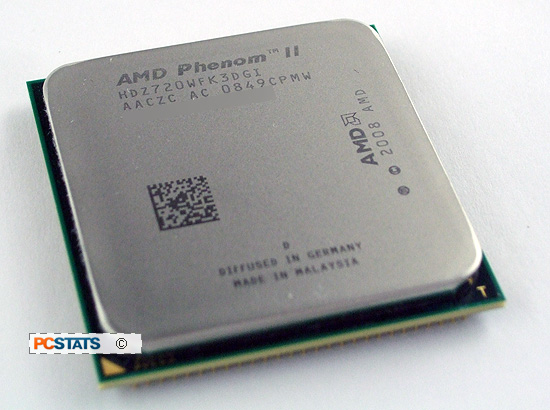Socket AM3 and compatibility
The second is a shift to a 45nm production process, which shrinks the size of
the transistors inside the processor so they lose less power and become more
energy-efficient. Having less wasted power also means that the overall
temperature of the processor goes down.
Socket AM3 and compatibility
 This handy chart helps explain some of the confusion that is AMD's current
lineup of CPUs and motherboards. The new Phenom II processors will be launching
in socket AM3 (938 pin) and socket AM2+ (940 pin) versions. The Phenom socket
AM3 processors are actually backwards compatible with socket AM2+ motherboards
and have unofficial compatibility with socket AM2 motherboards as long as those
motherboards support 140W processors and have appropriate BIOS updates. This handy chart helps explain some of the confusion that is AMD's current
lineup of CPUs and motherboards. The new Phenom II processors will be launching
in socket AM3 (938 pin) and socket AM2+ (940 pin) versions. The Phenom socket
AM3 processors are actually backwards compatible with socket AM2+ motherboards
and have unofficial compatibility with socket AM2 motherboards as long as those
motherboards support 140W processors and have appropriate BIOS updates.
When the socket AM3 version of Phenom II is running in a socket AM3
motherboard, it can take advantage of its integrated DDR3 memory controller.
When it's placed in a socket AM2+ or socket AM2 motherboard, it will change its
memory controller into DDR2 mode. This makes it easy for owners of older socket
AM2+ and AM2 motherboards to simply drop in a Socket AM3 Phenom II and enjoy an
easy performance upgrade.
The Phenom II socket AM2+ variant, and any other socket AM2+ and socket AM2
processors aren't forwards-compatible with socket AM3 motherboards. Although
socket AM3 processors have 938 pins, socket AM3 motherboards actually have 941
pins, and have changed the pin contact positions so that socket AM2+ and socket
AM2 processors won't be able to physically fit inside the new motherboard
socket.
Multi-cores explained
In recent years both AMD and Intel have started
changing their processors away from traditional single-processor designs.
Processors with multiple cores were introduced, with each core acting like
sub-processors inside a single physical chip. The switch to multiple cores was
made in order to keep up with the increasing amount of simultaneous tasks a
computer is doing in the background, sometimes while more intensive programs are
running n the foreground.
Just running Windows and having a program like Adobe Photoshop open at the
same time created a situation where a single-core processor would have to swap
between running Windows and then back to running Photoshop, and switching back
and forth between the two would waste processor cycles. Multiple cores are able
to handle this problem by having once core handle the Windows process, and one
core handling Photoshop, which made multi-tasking a whole lot faster.
| Intial AMD Socket AM3 Processors |
| Price |
Socket AM3
Processors |
Clock Speed |
L3 Cache
Size |
L2 Cache
Size |
Process |
Power |
| - |
Phenom II X4 910 |
2.6 GHz |
6MB |
2MB (512KB per core) |
45nm |
95W |
| $175 |
Phenom II X4 810 |
2.6 GHz |
4MB |
2MB (512KB per core) |
45nm |
95W |
| $200 |
Phenom II X4 805 |
2.5 GHz |
4MB |
2MB (512KB per core) |
45nm |
95W |
| $145 |
 Phenom II X3 720 Black Edition Phenom II X3 720 Black Edition |
2.8 GHz |
6MB |
1.5MB (512KB per core) |
45nm |
95W |
| $125 |
Phenom II X3 710 |
2.6 GHz |
6MB |
1.5MB (512KB per core) |
45nm |
95W | |
Now that processors have scaled to two, three, or four cores on a single
chip, software developers have started exploring new ways of taking advantage of
this extra processing output. Applications can split different parts of
their workload into separate threads, and then give each of those threads to a
separate processor core, further reducing processor bottlenecks. As
multiple-cores are a very recent development for desktop processors, not every
piece of software will take full advantage of them, and some applications will
remain much more suited to be run as a single thread instead of broken up into
smaller, multi-threaded computations.
There are already a few applications that can take advantage of lots of cores
running in parallel. Video encoding in programs like Adobe Premier or Windows
Media Encoder can let each core encode a single frame at a time, and 3D
rendering programs like 3D Studio MAX can let each core calculate a separate
frame for rendering. Other multi-threaded applications like particle
simulation, weather forecasting and material physics can also take advantage of
extra processor cores, but these programs are generally made for specific niche
markets, and most users will never hear of them, let alone use them.
|
